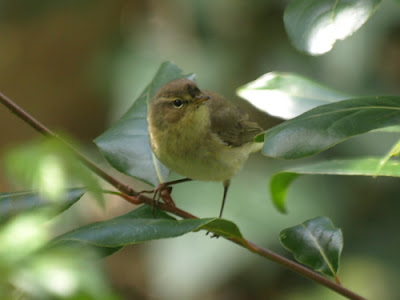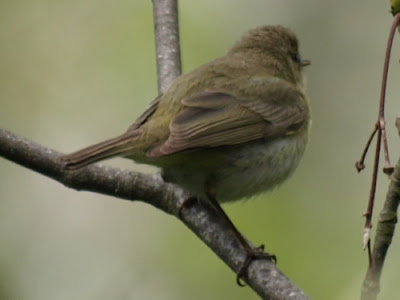Shelduck 3E
Returned to Apuldram and spent a couple of hours listening to the oddly-singing Chiffchaff obtaining some further recordings, some video and images. As on the evening Bernie first found this interesting songster, I consider it was again today delivering a varied reportoire. Whilst others have considered it singing similarly to XC70429 recorded in the Netherlands on xeno-canto, it was again hard to reconcile today's performance by the Apuldram Chiffchaff with such a structured song, that to my ear, is terminated early just the once, but otherwise sounds rather constant in delivery, includes one central 'sweep' note and lacks the opening Chiffchaff-like sequence of the Apuldram bird. Vocal comparisons with another vagrant may also be of less importance than comparisons with birds recorded from the species core range in Spain, albeit hypocritically, I was happy to contrast the song with those previously heard in the UK!! In the latest article to appear on the species in Birding World May 2010 it does state that the 'conflict' song of Iberian Chiffchaff sounds more like the familar songs of Common Chiffchaff - a subject I know nothing else about - and there has been a lot of playback at Apuldram. However, it warns of the possibility that Common Chiffchaffs may sound superficially like Iberian Chiffchaff because they have learned the song of Iberian Chiffchaff and that it is important to remember that these 'mixed singers' can complicate the issue...
Common Scoter 71E
Velvet Scoter 2E
Red-breasted Merganser 1E
Peregrine 2
Curlew 1E
Arctic Skua 1E
Bonxie 1E
Black Headed Gull 17W
Sandwich Tern 17E
Commic Tern 14E
Auk sp. 2W
Swallow 5 in off the sea
Song Thrush 2
Common Whitethroat 5
Blackcap 6
Chiffchaff 5
Willow Warbler 5
Long-tailed Tit 1
Grey Seal 1 off BirlingReturned to Apuldram and spent a couple of hours listening to the oddly-singing Chiffchaff obtaining some further recordings, some video and images. As on the evening Bernie first found this interesting songster, I consider it was again today delivering a varied reportoire. Whilst others have considered it singing similarly to XC70429 recorded in the Netherlands on xeno-canto, it was again hard to reconcile today's performance by the Apuldram Chiffchaff with such a structured song, that to my ear, is terminated early just the once, but otherwise sounds rather constant in delivery, includes one central 'sweep' note and lacks the opening Chiffchaff-like sequence of the Apuldram bird. Vocal comparisons with another vagrant may also be of less importance than comparisons with birds recorded from the species core range in Spain, albeit hypocritically, I was happy to contrast the song with those previously heard in the UK!! In the latest article to appear on the species in Birding World May 2010 it does state that the 'conflict' song of Iberian Chiffchaff sounds more like the familar songs of Common Chiffchaff - a subject I know nothing else about - and there has been a lot of playback at Apuldram. However, it warns of the possibility that Common Chiffchaffs may sound superficially like Iberian Chiffchaff because they have learned the song of Iberian Chiffchaff and that it is important to remember that these 'mixed singers' can complicate the issue...
Here follows a few more recordings from today:
Many thanks for advice received from Martin Garner in preparing the above sonogram with Raven Lite software being the opening sequence of song from the video above. As I am a novice at interpreting sonograms here are a few tentative comparisons that should be viewed with caution. Whilst the Stiffkey Fen Iberian Chiffchaff in April 2010 had notes ranging between about 3kHz and 6.5kHz, being described as a lower frequency than that employed by Common Chiffchaff (Biring World Vol. 23 No. 4), the sonogram above reveals the Apuldram Chiffchaff has notes ranging between about 3.4kHz and 7.4kHz. Also, the central rising 'sweep' notes, that appear to be diagnostic of Iberian Chiffchaff (Birding World Vol. 23 No. 4), and appear on a sonogram as an inverted V are absent - seemingly confirming our impressions gained in the field. Looking at the sonograms presented in Birding World Vol. 12 No. 5 p.198 the terminal rattle of Iberian Chiffchaff is portrayed by near-vertical lines lacking the tail and of uniform frequency - additionally, the sonograms on p.197 show the terminal rattle being at a lower frequency than the opening sequence. In contrast, the terminal phrase of the Apuldram Chiffchaff, if it qualifies as such, appears longer in length, slower in delivery and is comprised of Common Chiffchaff-like notes complete with tails, the frequency of the notes are inconsistent and none of the notes are at a lower frequency than those of the opening sequence.
The complete sonogram from the video above
It is worth noting the similarity of the notes, and frequency thereof, contained within the sonogram of a Common Chiffchaff recording in Nottinghamshire by Frank Lambert on 19th March 2011:
Although slightly slower in delivery, and lacking the odd quickly-repeated note, the notes, length of sequence and frequencies are a very close match.
Here's a sonogram of another Common Chiffchaff recorded by Ruud van Beusekom in Holland on 30th March 2009:
Note that in this phrase the song consists of sixteen notes as do the phrases of the two sonograms of the Apuldram Chiffchaff above.
In contrast, here is the sonogram at the same scale of an Iberian Chiffchaff recorded in Spain by Fraser Simpson on 15th April 2010:
The diagnostic three 'sweep' notes are very obvious. The terminal rattle consists of just two notes. As with the Stiffkey Iberian Chiffchaff the lowest frequency notes are below 3kHz.
Here is the sonogram at the same scale of an Iberian Chiffchaff recorded in Walderslade, Kent by Joe Stockwell on 3rd May 2010:
Two diagnostic 'sweep' notes and very obvious rapidly-delivered terminal rattle. As with the Stiffkey Iberian Chiffchaff the lowest frequency notes are below 3kHz.
The central section of song from the video of the Apuldram Chiffchaff above
As the three sonograms of the Apuldram Chiffchaff above are far from uniform it confirms the variability and inconsistent nature of the song being delivered by the Apuldram Chiffchaff.
Here are some images taken in strong sunlight, when I suspect reflection from the surrounding vegetation, results in the apparent green and yellow hues to the bird's plumage:

But something of a chameleon, in more neutral light, the bird appeared far more colourless and really quite drab being very similar to our impressions of it based on our views the first evening in cloudy overcast conditions:
On a quick comparison to features included in the latest article to appear on the species in Birding World May 2010, in addition to our ongoing concerns about its variable song, based on views obtained and the images above (albeit with the caveats re the difficulties of assessing images of Chiffchaffs) the following would seem to me to be at odds with a 'typical' Iberian Chiffchaff. When viewed in neutral light, very little evidence of yellow in the supercilium, throat or undertail-coverts. Upper breast could appear rather sullied and forms a breast band, certainly not white. Its ear-covert patch is well-marked, so no open-faced appearance and accentuates its white lower eye-ring crescent. The colouration of its upperparts look unexceptional.
That all said, it certainly does react strongly to playback of the song of Iberian Chiffchaff (although also to Common Chiffchaff http://thenaturequest.blogspot.co.uk/2012/04/apuldrum.html )... and I am certainly no expert... as previously stated, I've only seen two (UK) Iberian Chiffchaffs.



















































